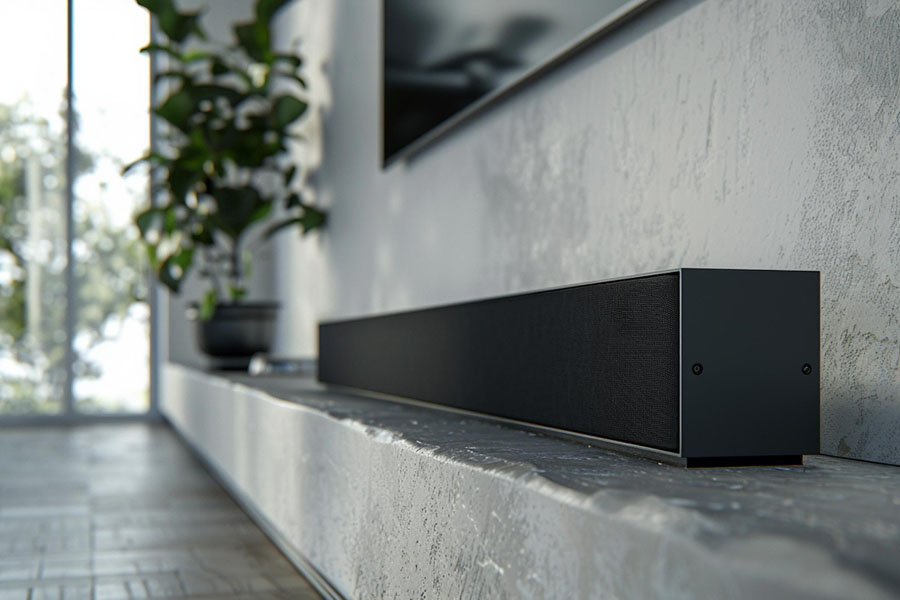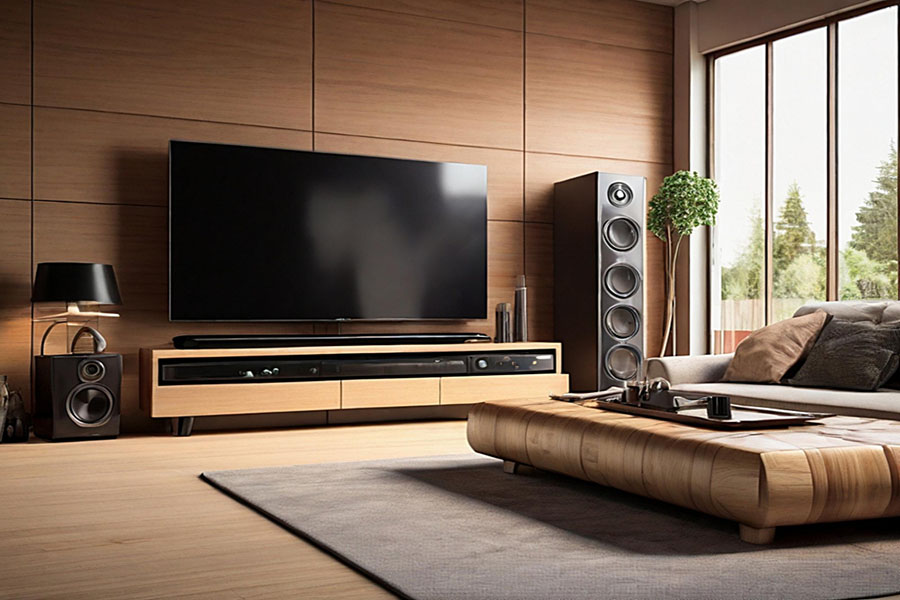A home theater system is designed to provide an immersive audiovisual experience, and a subwoofer is crucial in delivering deep, powerful bass. However, nothing can ruin that experience faster than an annoying buzz from your subwoofer. But why does my home theater subwoofer buzz?
This common issue can stem from various sources, from electrical interference to faulty cables. So, this article explores the potential causes of subwoofer buzzing and offers practical solutions to help you restore the pristine sound quality of your home theater system.
Whether you’re a seasoned audiophile or a casual listener, understanding and addressing subwoofer buzz will enhance your overall enjoyment of your audio setup. Let’s get started!
Why Does My Home Theater Subwoofer Buzz?
A buzzing subwoofer can be a frustrating issue, disrupting the immersive audio experience of your home theater system. Identifying the root cause of the buzzing noise is crucial for resolving the problem and ensuring optimal sound quality.
So, several potential causes can lead to a buzzing subwoofer; troubleshooting these issues systematically can help pinpoint the exact source. Some of them are the following:

Electrical interference
Electrical interference can cause subwoofer buzzing when electromagnetic signals from nearby electronic devices disrupt the audio signal. Devices such as routers, smartphones, and microwaves emit electromagnetic fields that create an audible subwoofer buzzing when turned on, thus interfering with the subwoofer’s circuitry.
Power cables running parallel to audio cables can also introduce noise, leading to a buzzing sound. This interference typically occurs because the subwoofer’s sensitive components pick up unwanted signals, which are amplified along with the audio signal.
Tips for minimizing electrical interference
To minimize interference, you should ensure proper cable shielding and routing of audio and power cables. Separate them from potential sources of interference like TV cables or computer peripherals.
Additionally, using a power conditioner or line filter can help eliminate electrical noise from the AC power supply. It filters out high-frequency interference before reaching your audio equipment.
Ground loop isolation
Ground loops occur when there are multiple grounding paths within an audio system, creating a loop of electrical current between devices with different ground potentials. This loop can introduce a low-frequency hum or buzz into the audio signal, which is often heard through the subwoofer.
Ground loops are commonly caused by equipment being plugged into different electrical outlets. This leads to varying ground references.
Potential solutions
Eliminating ground loops involves several strategies to ensure all connected equipment shares the same ground potential. You need to start by plugging all audio components into the same power outlet using a high-quality power strip. This minimizes potential differences between devices.
Alternatively, you may use a ground loop isolator to break the loop without affecting audio quality. Plus, you must ensure all devices are properly grounded, so check for loose or disconnected ground wires. For more persistent issues, a dedicated audio transformer can isolate the audio signal, effectively eliminating the ground loop.
Improper connections
Improper connections can wreak havoc on your audio experience, leading to annoying subwoofer buzzing and other frustrating audio issues. One common culprit is loose or incorrectly plugged cables, which can introduce interference and degrade the signal, ultimately harming the sound quality you crave.
Ensure all connections between your subwoofer, receiver/amplifier, and speaker wire terminals are secure and perfectly made to maintain pristine audio. Start by unplugging all cables and thoroughly inspecting them for any signs of damage or looseness. Then, with a steady hand and keen eye, firmly re-insert each cable into its designated port, ensuring a snug fit that leaves no room for error.
When it comes to speaker wires, attention to detail is key. Carefully strip away the insulation and tightly twist the exposed strands together to create a solid connection. Opting for high-quality shielded cables with robust insulation can minimize buzzing caused by pesky external interference and signal leakage.
And let’s not forget about proper cable routing. By carefully organizing your cables and ensuring they follow the optimal path, you can prevent unwanted noise and guarantee the smooth transmission of your beloved tunes.

Mechanical issues
Subwoofer buzzing can stem from various mechanical issues, disrupting your audio bliss. Loose components within the subwoofer itself, such as screws or internal fittings, can vibrate against the enclosure, generating unwanted noise.
Similarly, worn-out or damaged speaker cones may produce buzzing or rattling sounds during operation. Another culprit is inadequate ventilation or airflow around the subwoofer, causing overheating and subsequent buzzing. Additionally, placement on unstable surfaces or near vibrating objects can transfer vibrations to the subwoofer, amplifying buzzing issues.
Inspecting for physical damage
You should remove the subwoofer’s grille or cover to inspect for mechanical issues. Take a close look for any visible signs of damage to the speaker cone, surrounds, or dust caps.
As you gently move the cone back and forth, listen for any unusual rubbing or scraping sounds. These could suggest a loose voice coil or debris inside the enclosure.
Maintenance and repair
Regular maintenance is crucial in preventing mechanical issues. Also, cleaning dust buildup with a soft-bristled brush or compressed air keeps components debris-free.
If you notice physical damage, replacing damaged parts or consulting professional repair services may be necessary. This approach restores optimal performance and eliminates any bothersome buzzing sounds.
Troubleshooting and Resolution
Identifying the source of a buzzing noise from your subwoofer is crucial for resolving the issue effectively. Hence, you can follow these step-by-step instructions to troubleshoot the problem:
- Isolate the source: begin by isolating the subwoofer from other audio components to determine if the buzzing noise originates from the subwoofer itself or another component in your audio system.
- Check connections: inspect all cable connections between the subwoofer and the receiver or amplifier. Ensure they are securely connected and free from any visible damage.
- Eliminate interference: move the subwoofer to a different location to rule out potential interference from nearby electrical devices or appliances that may be causing the buzzing noise.
- Inspect the subwoofer: carefully examine the subwoofer’s enclosure, woofer cone, and surrounding area for any visible signs of damage, such as a torn surround or debris obstructing the woofer’s movement.
Potential solutions based on the identified cause
Once you have identified the cause of the buzzing noise, you can explore various solutions to resolve the issue. Here are some potential solutions based on the identified cause:
Equipment placement and isolation
If the buzzing noise is caused by external interference or vibrations, adjusting the subwoofer’s placement or installing isolation devices can be effective solutions. You can do the following:
- Relocate the subwoofer: move the subwoofer to a different location, away from potential sources of interference or vibrations, such as walls, floors, or other audio components.
- Use isolation pads or feet: install isolation pads or spiked feet under the subwoofer to decouple it from the surface it rests on, reducing the transfer of vibrations and minimizing buzzing.
Repairs and component replacement
Repairs or component replacement may be needed to resolve the issue effectively if the subwoofer’s damaged or defective component causes the buzzing noise. So, you can try to:
- Replace the subwoofer driver: if the subwoofer’s woofer cone or surround is damaged, replacing the driver with a new one can resolve the buzzing issue.
- Check and replace amplifier components: the buzzing noise may sometimes originate from a faulty amplifier component within the subwoofer. Consulting a professional technician or the manufacturer for repair or replacement options may be required.
Remember, if you are uncomfortable performing any of these troubleshooting steps or repairs, it is recommended to consult a professional audio technician for assistance.

Conclusion
To sum up, why does my home theater subwoofer buzz? The frustrating buzz of a malfunctioning subwoofer can quickly undermine the immersive experience of a home theater system. So, you can now take the necessary steps to eliminate unwanted noise and enjoy crystal-clear sound.
From electrical interference to improper connections, this article explored the diverse factors that can contribute to subwoofer buzz, providing troubleshooting tips and repair strategies along the way. But following the guidance outlined here, you can identify the root cause of your subwoofer’s buzz and implement effective solutions to eliminate it.

